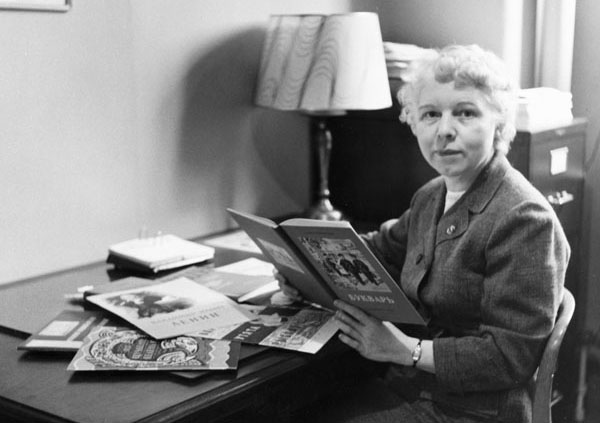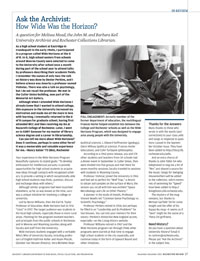In Review
 FULL ENGAGEMENT: An early member of the former department of education, the multilingual Frances Horler helped establish ties
between the College and Rochester schools as well as the Wide Horizons Program, which was designed to engage area young people
with the University. (Photo: University Libraries/Department of Rare Books, Special Collections, and Preservation)
FULL ENGAGEMENT: An early member of the former department of education, the multilingual Frances Horler helped establish ties
between the College and Rochester schools as well as the Wide Horizons Program, which was designed to engage area young people
with the University. (Photo: University Libraries/Department of Rare Books, Special Collections, and Preservation)Thanks for the Answers
Many thanks to those who wrote in with the words (and corrections) to your class yells and songs in response to questions I posed in the September-October issue. They have been added to http://rbscp.lib.rochester.edu/yells.
And an extra chorus of thanks to John Tobin ’64 who telephoned to sing me a bit of “Rex” and shared a source for the music: Songs for Swinging Housemothers will be added to the collection. John’s memories of swimming for “Speed” have been added to the libraries’ Living History site.
The mystery of the mug remains, but thanks to Michael Garfield ’58 for some insight and the offer of his Kappa Nu mug—it seems as if ”Jane“ might be the name of a Theta Chi girlfriend.
Need History?
Do you have a question about University history? Email it to rochrev@rochester.edu. Please put “Ask the Archivist” in the subject line.
As a high school student at Eastridge in Irondequoit in the early 1960s, I participated in a program called Wide Horizons at the U of R. In it, high school seniors from schools around Monroe County were selected to come to the University after school once a month during part of the school year to attend talks by professors describing their academic fields. I remember the names of only two: the talk on history was done by Dexter Perkins, and I believe science was done by a professor named Vishniac. There was also a talk on psychology, but I do not recall the professor. We met in the Cutler Union building, now part of the Memorial Art Gallery.
Although when I attended Wide Horizons I already knew that I wanted to attend college, this exposure to the University increased my motivation and made me all the more in love with learning. I eventually returned to the U of R campus for graduate school, having first attended MCC and then receiving my BA at Nazareth College of Rochester. Later, I went on to SUNY Geneseo for my master of library science degree and a career in librarianship.
Can you tell me more about Wide Horizons? Does it continue, perhaps in some other form? It was a memorable and valuable experience for me.—Nancy Salzer ’73 (MA), Rochester
Your experience in the Wide Horizons Program beautifully captures its stated goals: “To develop enthusiasm for intellectual pursuits; to provide opportunities for high school students to acquire new ideas through contacts with recognized scholars; to provide a setting in which exceptionally able high school students may think, question, discuss and exchange ideas with others.”
Although similar programs had been launched elsewhere, as far as was known at the time, ours was a unique initiative for involving a college or university.
Led by Byron Williams, then the Earl B. Taylor Professor of Education, Wide Horizons had its first “class” in 1957. The target audience was students in the local high schools, especially those in more rural areas. Planning for the program involved teachers and principals from the public schools in Rochester, and in Monroe and Wyoming counties along with faculty and staff from the University.
Wide Horizons students engaged with a veritable Who’s Who of University faculty, including professors of English Kathrine Koller and Hyam Plutzik, Glyndon Van Deusen (history), Vera Micheles Dean (political science), J. Edward Hoffmeister (geology), Glenn Wiltsey (political science), Frances Horler (education), and Colin Turbayne (philosophy).
According to a 1962 press release, you and 174 other students and teachers from 34 schools had a dinner event in September in Cutler Union, then were divided into five groups and met there for seven monthly sessions; faculty traveled to sessions with students in Wyoming County.
Professor Vishniac joined the University in 1961 and had yet to perfect his “Wolf Trap,” a device to obtain soil samples on the surface of Mars; the session you recall with him was entitled “Space Microbiology and Life on Other Planets.”
A pioneer in the study of moods, Professor Vincent Nowlis led “Common Sense Psychology vs. Scientific Psychology.”
Professor Perkins retired in 1954, but perhaps he filled in on “Leadership and Its Problems” for Van Deusen. You can test your memory for their voices—Perkins’s distinctive New England accent, especially—on the Living History website.
Professor Williams retired in 1967 and the Wide Horizons program ran through 1968; other programs were started at that time to engage high school students in the city especially, and continue today in the form of Upward Bound and other initiatives.

